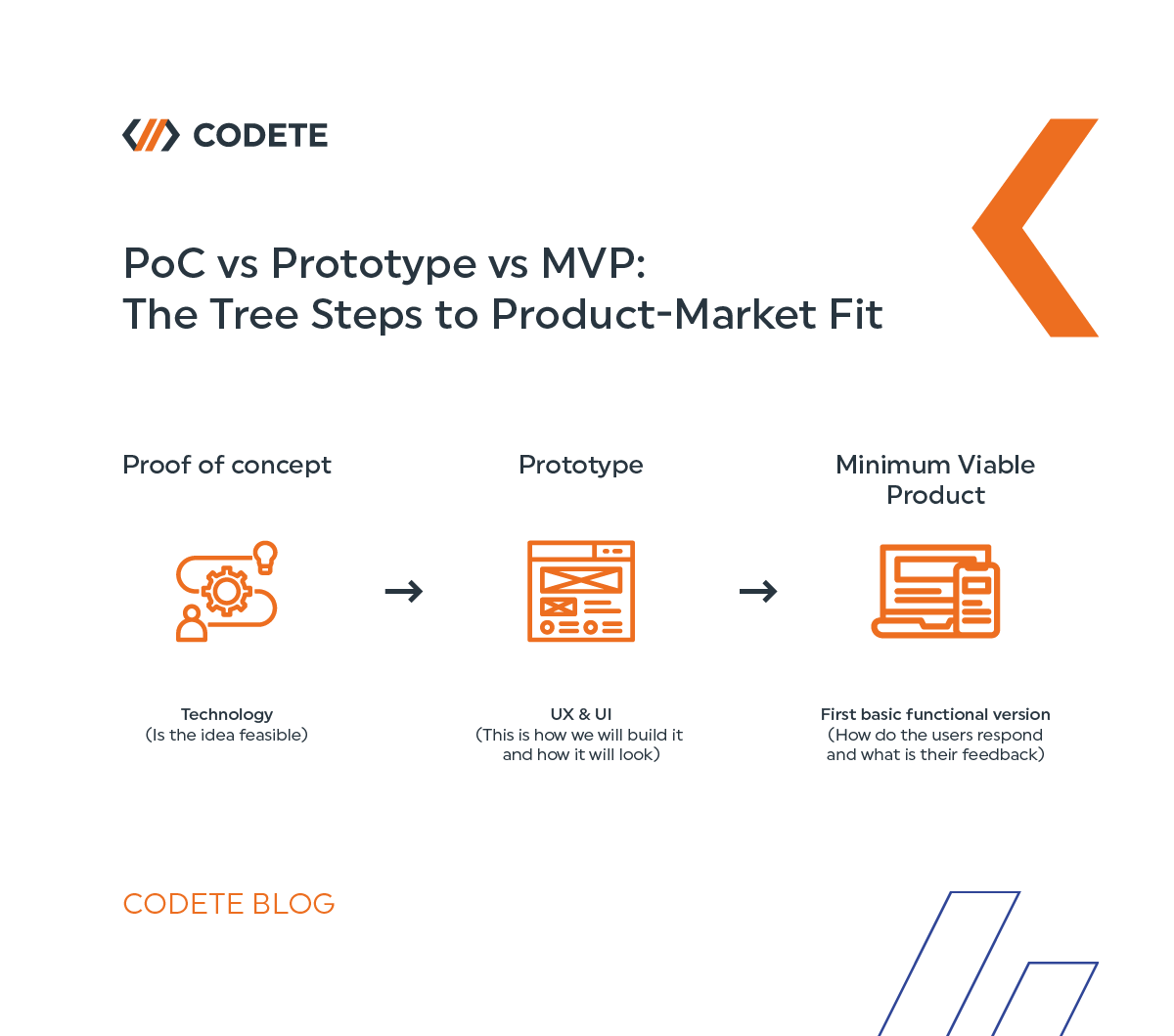Every business is looking for new products due to the intense and resounding competition for solutions that meet the market's most pressing needs. A well-designed software concept, however, must be validated with real-world users.
Table of contents:
- Proof of concept. What do you need to know?
- Prototype. What is it?
- How about MVP?
- POC vs. prototype vs. MVP – similarities and differences
- Proof of concept vs prototype – summary
Due to the ever-increasing complexity of software-related tasks, businesses tend to employ multiple teams at once. Naturally, each team is driven by the desire of their client to outperform existing systems, create novel customer experiences, and launch new business initiatives. As a result, a significant software development backlog is rapidly outgrowing its estimation, consuming increasing amounts of time and money.
Poor planning, budget overruns, and other management blunders are the primary causes of product (or product improvement) ideas not being realized. That’s why it's so crucial to test the software concept, central layout, features, and key-value proposition before creating a fully-fledged product.
This is possible through Proof of Concept (POC), Prototype, and Minimum Viable Product (MVP) methodologies. They are intended to help your company establish delicate assumptions, elicit user desires, and define a clear path for product development.
But what exactly are they?
Proof of concept. What do you need to know?
To begin, let me state confidently: you should never develop your software or features in a blind manner. You'll waste all of your resources this way. Rather, it is advised to determine whether the product concept generates genuine interest and anticipates a need among its target audience.
Creating a Proof of Concept (POC) is the most efficient and accurate method of validating fundamental assumptions about your target users and software concept. Consider it a technical exercise that confirms the viability of specific ideas or processes for use in the real world. In other words, using POC will allow you to determine whether your product has the potential to develop.
This is a low-cost method of determining the technical feasibility of your product. It clarifies whether you build the product without experiencing significant setbacks. As a result, it is highly recommended in situations where the product or concept you wish to develop is unique to the market (as in, it does not exist yet).
Before creating a POC, create a customer journey and service blueprint. Both tools will help you understand the various moving parts required to make your service work. Determine which of these components uniquely distinguishes your solution. These are precisely the components that should be validated through a proof of concept.
POC's purpose is to validate functional assumptions, determine technical feasibility, identify potential bottlenecks, determine customization efforts, and detect potential performance issues. It puts your assumptions about how the technical aspects of the product will work to the test. This is accomplished by thoroughly testing minor aspects of the product to ensure that they function properly.
Nonetheless, proof of concept should never be mistaken for a finished product. It is a low-effort build that can be tested on a small group of people.
Read more: Proof of Concept - How to Do It Right
Prototype. What is it?
After you've decided on the technical aspects of your product, you are ready to create a prototype – an early version with a limited set of features designed to validate a concept or process. This is usually the first draft of a product after the proof of concept process has validated it. Its goal is to ensure the final product closely embodies the company's concepts and functions while meeting specific project requirements.
To determine that, create prototypes based on your top features for early user testing. To pick them, assess the value of each feature you intend to include in your solution. On a business level, the value may refer to a feature's ability to increase revenue, enter a new market, or gain market share on a business level. Now, rate each feature numerically based on the value it provides and the effort required to implement it.
After that, plot the features on a graph: The X-axis represents value, and the Y-axis represents complexity/effort. The elements in the upper left quadrant of the chart should be prioritized. They represent those with the most significant value to your company and target market, as well as the least amount of implementation or development effort.
Developing a prototype is a loop process in which product teams constantly review and refine the concept until the company’s goals and consumer needs are fully met. Naturally, a prototype will contain errors, but discovering these errors during the early stages of production is one of its purposes. In general, this approach enables the discovery of novel ideas and confirmation of the most profitable route for the product roadmap; allowing for critical changes early in the development (which saves lots of money).
The purpose of a prototype is to effectively communicate the intelligent design and navigation flow of an innovative product to maximize improvement efficiency. A prototype depicts how a product will appear and behave by demonstrating user flows illustrating the functional design and layout. It specifies how a user will interact with the solution.
The most popular prototype versions are:
- A paper prototype is a quick, low-cost, non-technical way to test the viability of product features. This user-centered approach assists in determining what happens when users perform specific actions on your app or website.
- A clickable wireframe prototype depicts how the app or website appears and functions. It only displays the essential design elements and content and does not yet have a fully coded back-end. When you click on features in the wireframe, they respond as an authentic product.
Both types can be tested with a small group of potential users, preferably unfamiliar with the product. They are also ideal for sharing with project managers, stakeholders, clients, or investors who need to be convinced that the project is worthwhile. They can go through many iterations, with new versions improved based on user feedback.
As you can see, prototyping is a crucial stage in the software development process – it allows you to identify the application's core flows, usefulness, and specific features to test. It determines how your product will be implemented, how it will look, how it will be used, and so on. All that, while being a valuable exercise for determining how people will react to your anticipated product.
After you've validated your digital product's technical, functional, and user experience aspects, you can start working on a minimum viable product.
How about MVP?
As the term implies, a Minimum Viable Product (MVP) is an early version of the technical solution with core functionalities and a compelling value proposition – which is still a work in progress. It is intended to validate critical assumptions or hypotheses surrounding a business model or value proposition.
However, the most widespread misconception about MVPs is that no one would release an incomplete product to market. Let’s address that issue – you need to be aware that identifying and implementing this concept is critical to your product's success.
Through using an MVP, you can avoid wasting time and resources developing solutions that no one wants to use. By leveraging the insight and learnings of legitimate users, you can direct your time, effort, and financial resources to areas that best meet your middle enterprise objectives.
To put it another way, MVP’s goal is not to develop a limited version of your product or service. MVP's goal is to learn as much as possible with as little effort as possible. It enables an application to be carefully shaped over time, starting with its core concept and progressing through subsequent value additions validated by users.
Building an MVP is an iterative process that identifies user pain points and accurately determines the appropriate capability to address those needs over time. The methodology enables your team to recognize users' pain points while testing your app in the target market by encapsulating the expected product's primary value and answering whether or not it is viable.
Later on, based on user feedback, you can edit the product to provide a more comprehensive, cleaner, and user-friendly solution. In fact, MVP lets you maximize your ROI with each release version and eventually transition to a fully functional application.
Examples of MVPs:
- The Data Sheet; Make a data sheet outlining the specifics of the value proposition you envision. This can be done quickly and easily with a word processor or spreadsheet software, and you'll be able to promptly share your idea with customers and partners to gather early feedback.
- Storyboard; Create a storyboard that demonstrates how your value proposition solves a real problem for customers. Customers may relate to your value proposition if they imagine themselves in a situation where they would use your product or service.
- Landing Page; Create a quick webpage outlining the key benefits and components. Include a clear call-to-action for your target customer so that you can track their behavior concerning your product or service.
- Product Container; Designing a prototype of the product packaging for your imagined value proposition is a very effective MVP for physical products. Put it in customers' hands to see how they interact with it and react to different aspects of the value proposition.
- Prototype for Learning; In a higher fidelity experiment, you can build a working prototype of your value proposition. Ensure that you only include the most basic feature set required to gain the desired learning.
In the early stages of a new venture, it's critical to experiment with various MVPs and alternative methods of testing your ideas, uncover your customers' actual attitudes and behaviors. That's why it's always a good idea to use a combination of tests and experiments.
And remember, all of today's most successful solutions began as something much more straightforward than they are now. Uber, Instagram, and Spotify are all mature applications; they result from years of development and considerable capital investment. Developing a similar application requires several times the investment.
POC vs. prototype vs. MVP – similarities and differences
When creating a product from the ground up, it's critical to consider proof of concept, prototype, and MVP. To do so, always assume that what you believe users want is not always what they actually require.
Although the terms POC and Prototype are frequently used interchangeably, they have completely different meanings.
The proof of concept does exactly what it says: it proves a concept. It determines whether or not a specific idea can be made a reality. As a result, POC is ideal for application concepts and market-specific operational capabilities. The main goal of each product development iteration here is to keep things as simple as possible, focusing on the single question or feature that needs to be investigated.
Prototyping is a technique for identifying system errors and validating a product's design, usability, and, in some cases, functionality. It is typically carried out once the viability of your concept has been established. A prototype is ideal for thoroughly testing the entire application's layout, particularly on a larger project where we may go through several concepts before coming to a conclusion. When used properly, the process elicits new ideas and establishes the best course of action throughout development.
POC | Prototype | MVP | |
| What is it? | A small project created to test whether a certain idea can be implemented | An incomplete version of the software that only stimulates a few aspects of the final solution | A version of the product that has just enough features to be viable |
| What is tested? | Technical assumptions/ hunches and their potential | Product’s design, usability, and functionality | The core of solution (and its adaptability) in real-life scenarios |
| Main goal | Identify operational feasibility of the concept/assumption to justify further development | Offers the first look, feel of the project | Gives a basic working model that can be implemented and deployed into production |
| When is it used in the project? | Early stage | Early stage | Live testing (feedback collection) |
| Target audiences | Internal use only | Decision-makers, users, | Sizable customer groups |
| Main benefit | You won’t waste money on a solution that can’t be produced | You will have insight into project potential weak spots | You will be able to verify your product with the market needs |
While the MVP concept is to build a basic application and gradually expand it with subsequent fee additions over time, the POC and Prototype serve as standards for confirming application layout while the application is still in development. Each launch version evolves the specific product naturally in order to maximize ROI and progress toward a fully mature application.
And, if you're still unsure about the difference between POC and MVP, keep in mind that if you are uncertain about something technical, you should create a proof of concept (not an MVP) to determine whether it works or not.
Proof of concept vs prototype – summary
With increased knowledge of POCs, prototypes, and MVPs, you'll be able to avoid common product development mistakes by testing for feature validity or market viability to ensure product fulfillment. Because each of the three approaches affects the user, a thorough understanding of each component and selecting an appropriate technique will assist the stakeholder in maximizing the likelihood of success of their idea among the user and all.
If you want to boost the success of your product launch, implementing one or more of these techniques will help you avoid common product mistakes, ranging from faulty features to a product that has no place on the market at all. Each approach is tremendous when used correctly, whether for early testing critical business standards, prevailing over stakeholders, or validating marketability. So, if you've ever debated whether POC vs. MVP vs. Prototype is better, you should have considered developing a product that encompasses all of these stages.
You can be confident that the well-considered proposal you present to traders and stakeholders makes a compelling commercial enterprise case with numerous obvious return on investment (ROI) opportunities if you have the appropriate cogent evidence.
Have you already determined how to deliver your product to the target market? Share your ideas with us, and together we'll navigate the complex process of creating a valuable digital product for your users.


